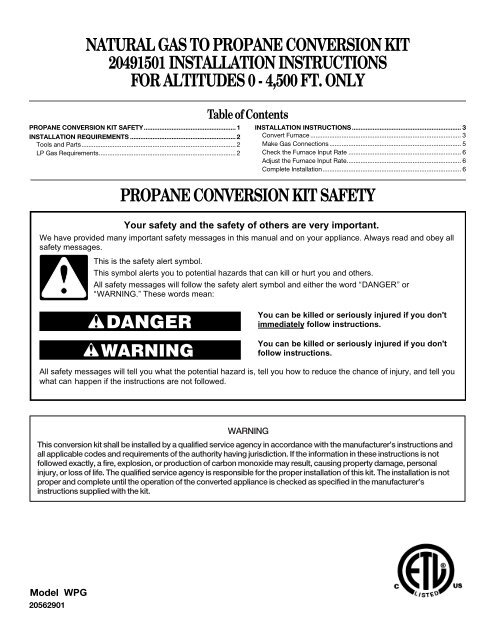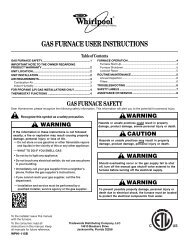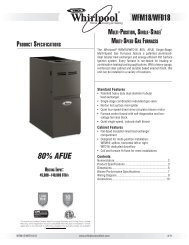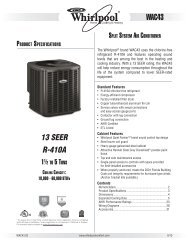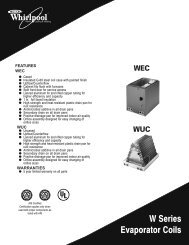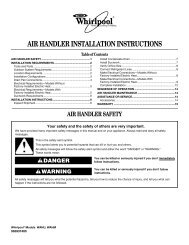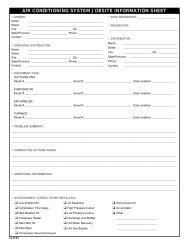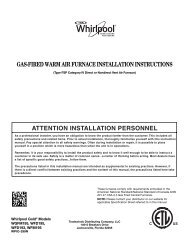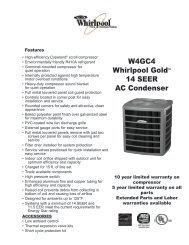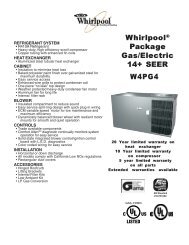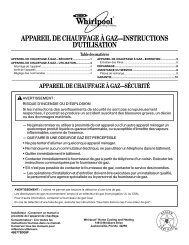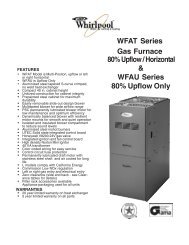Natural Gas To Propane Conversion Kit 20491501 Installation
Natural Gas To Propane Conversion Kit 20491501 Installation
Natural Gas To Propane Conversion Kit 20491501 Installation
You also want an ePaper? Increase the reach of your titles
YUMPU automatically turns print PDFs into web optimized ePapers that Google loves.
Convert FurnaceINSTALLATION INSTRUCTIONS6. Remove the manifold pipe from the burner assembly byremoving the 4 mounting screws.123345Explosion HazardFurnace must be installed and serviced by aqualified person.Examples of a qualified person include:licensed heating personnel,authorized gas company personnel.Read and follow all instructions provided forinstallation, adjustment, service, alteration, ormaintenance.Failure to follow these instructions can result in death,explosion, fire, or carbon monoxide poisoning.WARNING1. Orifice locations2. Rollout switch location3. Mounting screws4. Flame sensor location5. Manifold7. Slide the manifold pipe (with gas control valve) forward andout of the control compartment.8. Remove the regulator adjustment cap with “O” ring, pressureregulator adjusting screw, and spring from the gas controlvalve. See “<strong>Gas</strong> Control Valve.”<strong>Gas</strong> Control Valve1OFF23ONIN45PSI6Electrical Shock HazardDisconnect power before servicing.Replace all parts and panels before operating.Failure to do so can result in death or electrical shock.6781. Turn off gas supply at manual gas shutoff valve.2. Disconnect power.3. Remove the burner access door.4. Disconnect all wires from gas control valve.5. Disconnect the rollout switch and flame sensor wires.91. <strong>Gas</strong> control knob2. <strong>Gas</strong> outlet3. Outlet pressure tap4. <strong>Gas</strong> inlet5. Inlet pressure tap6. Regulator adjustment cap7. “O” ring8. Pressure regulator adjusting screw9. Spring3
9. Convert the <strong>Gas</strong> Control Valve for LP <strong>Gas</strong>.■ Open the plastic bag included in this kit.■Locate the new spring (different color) and install.■ Locate the new pressure regulator adjusting screw andthread in such a way that the top of the regulator adjustingscrew is flush with the surface of the gas control valve.■ Turn regulator adjusting screw clockwise 11 full turns.■ Install new “O” ring into new regulator adjustment cap(BLACK).■ Install the new regulator adjustment cap (BLACK).■ Affix the gas control valve conversion label included in theplastic bag to the top of the gas control valve.10. Remove the orifices from the manifold. Thread in the new #54LP <strong>Gas</strong> orifices located in the kit.NOTE: Make sure that the orifices are straight and positionedat a 90º angle to the manifold.11. Remove the #10 screws that secure the burner assembly tothe flue panel.12. Remove burner assembly from vestibule compartment. Becareful to support burner opening inlet plate.Manifold and Burner Assembly113. Remove two (2) screws securing top air shield to burnerassembly. Move top air shield to allow access to spoilerscrews holes. See “Manifold and Burner Assembly.”14. Install spoiler screws into each burner. Thread screw downuntil the head of the screw just touches the surface of theburner. Make sure not to overtighten. See “Orifice and SpoilerScrew Location.”15. Reinstall the top air shield.16. Reinstall burner assembly with burner opening inlet plate.Burner opening inlet plate must rest against flue panel.17. Reinstall the manifold pipe to the burner assembly.IMPORTANT: Ensure that the burner igniter is aligned properlywith the burner. The burner igniter tube should be alignedvertically as shown.121. Burner igniter tube2. Burner throat1224518. Affix the gas conversion manifold label “This control has beenconverted for use with propane gas” to the manifold in avisible location.19. Reconnect all wires on the gas control valve.20. Reconnect rollout switch and flame sensor wires.123331. <strong>To</strong>p shield2. Burner opening inlet plate3. ManifoldOrifice and Spoiler Screw Location124. Spoiler screw5. Burner341. Orifice locations2. Rollout switch location3. Mounting screws4. Flame sensor location5. Manifold451. Manifold2. Orifice3. Spoiler screw4. Burner21. Fill in the required information on the conversion plate label(day-month-year of conversion, and the name and address ofthe organization making this conversion).22. Attach conversion plate label to the exterior panel adjacent tothe unit rating plate.23. Replace the burner access door.24. Dispose of all remaining parts.4
Make <strong>Gas</strong> ConnectionsWARNINGFIRE OR EXPLOSION HAZARDFailure to follow the safety warnings exactly could resultin serious injury, death or property damage.Never test for gas leaks with an open flame. Use acommercially available soap solution made specificallyfor the detection of leaks to check all connections. A fireor explosion may result causing property damage,personal injury or loss of life.1. Install the field gas supply for either side or bottom gas pipeentry as shown.2. Provide a sediment trap on the outside of the furnace sectionin accordance with any local codes.3. Install a manual gas shutoff valve in the gas line, outside theunit in accordance with any local codes.4. Install a test gauge connection with a ¹⁄₈ in. NPT pluggedtapping immediately upstream of the manual gas shutoff valveas shown.5. Connect the gas pipe to the furnace controls providing aground joint union as close to the controls as possible tofacilitate removal of controls and manifold.Pipe-joint compounds suitable for use with natural and LP gasmust be used. Do not use Teflon ® tape.Side <strong>Gas</strong> Pipe EntrySide entry is the primary method of routing the gas supply tothe unit. Use the factory provided grommet to seal theopening around the gas pipe, preventing rain and moisturefrom entering the unit.Bottom <strong>Gas</strong> Pipe EntryWhen bottom entry of gas pipe is used, the side entry hole mustfirst be completely covered by a field-provided plug. Route thepipe up through the bottom entry hole and immediately into anelbow to route pipe along the base of the unit. Use another elbowto route gas pipe up through holes provided in control drawermount. One more elbow will route the pipe to the union and gascontrol valve.12341. Ground joint union2. <strong>Gas</strong> control valve3. Control drawer4. Bottom entry5. ¹⁄₈ in. NPT plugged tapping6. Manual gas shutoff valve7. Sediment trapCheck Inlet Pressure1. Turn off the gas supply at the manual gas shutoff valve.567126" Min.412351. Closed valve2. Open valve1. Manual gas shutoff valve2. ¹⁄₈ in. NPT plugged tapping3. Sediment trap4. Ground joint union5. Grommet2. Remove the inlet pressure tap plug on the gas control valve.3. Install a ¹⁄₈ in. NPT hose connector and connect the pressuregauge tube.<strong>Gas</strong> Control Valve1NPT OutletONOFFINNPT Inlet23PSI41. <strong>Gas</strong> control knob2. ¹⁄₈ in. NPT outlet pressure tap3. ¹⁄₈ in. NPT inlet pressure tap4. Regulator adjustment cap®Teflon is a registered trademark of E.I. Dupont de Nemours andCompany.5
4. Turn on the gas supply at the manual gas shutoff valve.5. Turn on the electrical power to the furnace.6. <strong>To</strong> light the main burners, set the room thermostat to a pointabove room temperature.NOTE: This furnace is equipped with an ignition device, whichautomatically lights the burner. This furnace cannot be lightedmanually. Do not try to light the burner by hand.7. Check minimum inlet gas supply pressure.■ Turn on all other gas appliances.■ Observe the pressure rating on the pressure gauge. Theminimum inlet gas supply pressure is 4.5 in. W.C. fornatural gas and 11 in. W.C. for propane gas.8. Check maximum inlet gas supply pressure.■ Turn off all other gas appliances.■ Observe the pressure reading on the pressure gauge. Themaximum inlet gas supply pressure is 10 in. W.C. fornatural gas and 13 in. W.C. for propane gas.IMPORTANT: If the inlet gas supply pressure is not within theminimum and maximum range as shown on the rating plate,contact your gas supplier.9. Turn off the electrical power to the furnace.10. Turn off the gas supply at the manual gas shutoff valve.11. Remove the pressure gauge tube and the ¹⁄₈ in. hoseconnector.12. Replace the inlet pressure tap plug on the gas control valve.13. Turn on the gas supply at the manual gas shutoff valve.14. Test all connections by brushing on an approved noncorrosiveleak-detection solution. Bubbles will show a leak. Correct anyleak found.■ At test pressures greater than ¹⁄₂ psig (3.5 kPa), thefurnace and the manual gas shutoff valve must bedisconnected from the gas supply piping system.■ At test pressures less than or equal to ¹⁄₂ psig (3.5 kPa), thefurnace must be isolated from the gas supply pipingsystem by closing the manual gas shutoff valve.Check the Furnace Input Rate(if required)BTU ratings shown on the furnace rating plate are for elevationsup to 2,000 ft.IMPORTANT:■ The furnace input rate must not exceed the input rating on thefurnace rating plate.■ For elevations above 2,000 ft, the ratings should be reducedat the rate of 4% for each 1,000 ft above sea level.■ This furnace is equipped for rated input at manifold pressureof 10.0 in. W.C. for propane gas.■ The actual heating value of your propane gas can be obtainedfrom your local gas supplier.Adjust the Furnace Input RateFor installations above 2,000 ft, the furnace input rate is to bereduced per the requirements of the National Fuel <strong>Gas</strong> Code(ANSI Z223.1/NFPA 54, latest edition), at the rate of 4 percent foreach 1,000 ft above sea level.1. Remove the burner access door.2. Move the gas control knob to the OFF position. Use only yourhand to move the gas control knob; tools are not required.3. Remove the outlet pressure tap plug on the gas valve andconnect pressure gauge to the ¹⁄₈ in. NPT outlet pressure tap.4. Be sure the gas control knob has been in the OFF position forat least 5 minutes before starting the unit.5. Move the gas control knob to the ON position.NOTE: This furnace is equipped with an ignition device whichautomatically lights the burner. This furnace cannot be lightedmanually. Do not try to light the burner by hand.6. Turn on the electrical power to the furnace.7. <strong>To</strong> light the main burners, set the room thermostat to a pointabove room temperature.8. Observe the pressure reading on the pressure gauge. Ifnecessary, adjust the manifold pressure to 10.0 in. W.C. forpropane gas.9. If necessary, remove the regulator adjusting cap on the gascontrol valve and turn the regulator adjusting screw clockwiseto increase pressure and input, or counterclockwise todecrease pressure and input.IMPORTANT: If the manifold pressure cannot be adjusted tothe correct value, contact your gas supplier.10. Move the gas control knob to the OFF position.11. Disconnect the pressure gauge from the ¹⁄₈ in. NPT outletpressure tap.12. Replace outlet pressure tap plug and the regulator adjustingcap on the gas valve.13. Move the gas control knob to the ON position.14. Replace the burner access door.15. Set the room thermostat to the desired temperature necessaryto achieve optimum temperature rise.Complete <strong>Installation</strong>IMPORTANT: Do not use this furnace if any part has been underwater. Immediately call a qualified person to inspect the furnaceand to replace any part of the control system and gas controlwhich has been under water.1. Check to be sure you have all of your tools.2. Dispose of all packaging materials.3. Check the furnace in its final location. Be sure the vent is notblocked.6
Measure Temperature Rise1. After 20 minutes of heating operation, measure the furnacetemperature rise. Take air temperature readings in both thereturn air ducts and the heated air ducts.2. If furnace doesn’t maintain temperature rise within the rangeshown on the furnace rating plate, adjust the blower speed.Adjust Blower SpeedWARNINGElectrical Shock HazardDisconnect power before servicing.Replace all parts and panels before operating.Failure to do so can result in death or electrical shock.NOTE: See the “Wiring Connection Diagram” while performingthe following procedure.Blower Speed Tap ChangeAt the Furnace Control Board1. Place red wire on the UNUSED terminal.2. Place blue wire (with piggyback terminal) on the COOLterminal.3. Place the factory supplied violet jumper wire from the COOLterminal to the HEAT terminal.<strong>To</strong> Select Different Speeds for COOL and HEATAt the Blower Motor Connector1. Disconnect power.2. Remove blower access panel.3. Place blue wire on the HIGH, MED or LOW motor speed tap,as desired for COOLING.4. Place red wire on any of the other motor speed taps forHEATING.At the Unit Control Board1. Remove and discard the violet jumper wire from the COOLterminal to the HEAT terminal.2. Place blue wire on the COOL terminal.3. Place red wire on the HEAT terminal.4. Replace blower access panel.5. Reconnect power.Factory Setting Heat/Cool SpeedsUnit Heat CoolWPG124, 130, 136, 148, 230, 236 MED MED1RedBlueWhiteLOWMEDHIGHCOMWPG248A125 MED MEDWPG142, 160, 242 MED HIGHWPG260A125 MED HIGHWPG224 LOW MEDWPG248A100 MED LOWRedBlueUNUSEDHEATCOOLViolet1. Blower motor connector2. Control board3. Jumper wire23Shut Down the Furnace1. Set the room thermostat to the lowest setting.2. Disconnect power.3. Remove burner access panel.4. Shut off the gas by moving the gas control knob to the OFFposition.5. Replace the burner access panel.See your Furnace <strong>Installation</strong> Instructions for troubleshootinginformation.<strong>To</strong> Select the Same Speed for COOL and HEATAt the Blower Motor Connector1. Disconnect power.2. Remove blower access panel.3. Place blue wire on the HIGH, MED or LOW motor speed tap,as desired.4. Place red wire on any of the other motor speed taps.5. Reconnect power.7
20562901© 2003. All rights reserved.10/03Printed in U.S.A.


